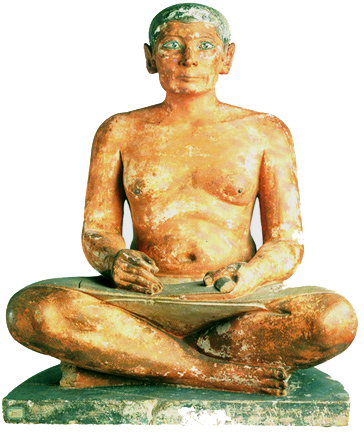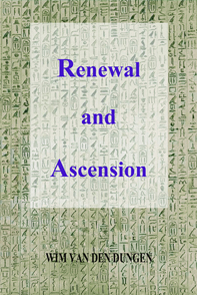|

the Scribe of
Saqqara
IVth or Vth Dynasty
Because
religion itself was an all-important factor in everyday life, religious
texts are a major part of Egyptian literature. Secular texts were
usually written on papyrus, but most have persished together with the
liberaries, offices and homes of the officials in which they were kept
(except if they were deliberately buried). Instead, religious texts were
inscribed on more permanent media, like tomb walls or stelae.
Religious texts fall into one of two categories : funerary and
devotional literature.
► FUNERARY LITERATURE
These are the oldest texts, and most extensively preserved. They tend to
be written in vertical columns of text rather than in horizontal lines
(some texts are arranged retrograde, the signs facing the end of the
text rather than its beginning). Let us discuss them chronologically :
1. The Pyramid Texts : Old Kingdom
This is a collection of rituals and magical texts in hieroglyphs
inscribed on the walls of the burial chamber, ante-chamber and other
rooms and corridors inside the royal pyramids of the Vth and Vth
Dynasties (initiated by
Pharaoh
Unis). As most
of these texts start with the expression "Dd-mdw" or
"words to say", egyptologists refer to them as
"utterances" or "spells". These nearly thousand
spells, ranging in length from a few words to several pages in a modern
translation, all belong to one of three categories :
-
Offering Rituals
: to be recited during the presentation of individual offerings, in
which the deceased is generally addressed as "Osiris", whereas the
offering itself is referred to as the "Eye of Horus". They are short
and often contain a "pun" on the name of what is offered. This
ritual began with a series of utterances designed to "wpt r" or
"open the mouth" of the deceased, so that the mummy could recover
its senses and powers in the afterlife before the offerings were
presented ;
-
Resurrection Rituals
: these long texts were also to be recited to the deceased and were
found in the antechamber and burial chamber. They were intended to
release the soul ("ba") from its attachment to the mummy, so that it
could begin its daily cycle (at night with the mummy, during the day
among the living), though on a different plane of existence, namely
as a spirit ("akh") like the gods ;
-
Personal Spells
: these line the walls of the other rooms and corridors of the royal
tomb, and had to be spoken by the deceased's soul as it made its way
through the night toward its rebirth at dawn. Originally in the
first person, they were often edited into the third person for each
tomb (substituting the name of the deceased for the original
first-person pronouns).
Scenes
from the tombs of officials show the same kind of rituals being
performed as given in the royal Pyramid Texts. Instead of the
Offering Ritual, these non-royal tombs often had an "offering
list", and the order of these offerings was usually identical to
the offerings mentioned in the Pyramid Texts.
2. The Coffin Texts : First Intermediate Period & Middle
Kingdom
The Coffin Texts
superceded the Pyramid Texts as early as the VIIIth Dynasty
(First Intermediary Period), but their principal sources are the later
cemeteries of the nomarchs of Middle Egypt in the XIIth Dynasty. Most of
them were written on papyrus or wood coffins in an early form of Middle
Egyptian, mostly in cursive hieroglyphs or sometime hieratic.
During the First Intermediate Period, officials began to inscribe
Resurrection Rituals and some Personal Spells from the Pyramid Texts
on the walls of their own burial chambers and coffins. These were often
accompanied by new spells, known as the Coffin Texts, a body of
nearly twelve hundred spells. Most are Personal Spells in the first
person and meant to give the soul save passage from the tomb to its new
spiritual life. In contrast to the Pyramid Texts, these spells
employ "vignettes" or illustrations (though only rarely).
These texts also contain a new type of funerary text, the "Books of
the Netherworld", or texts providing a description of the various
places in the "Duat" or netherworld, along with the words the
soul needed to know to pass safely through them. The most elaborate of
these guides is known as The Book of Two Ways, illustrated with a
map of the regions described. It still lacks the clear arrangement of
the later "Books of the Netherworld" like the
Amduat and starts the journey of
the soul through the hereafter with sunrise (and not, as later, at
dusk). These books represented the results of governement-funded
research into the hereafter !
The Coffin Texts eliminated the royal exclusivity of the Pyramid
Texts, for every deceased person had a soul and was an "Osiris
NN". The essential content of the Pyramid Texts remained,
but new motifs were added : transformation spells (the importance of the
scarab beetle), reunion spells, battle spells (against Apophis, the
gigantic serpent and enemy of Re) and the Judgment of the Dead. Although
the importance of Osiris greatly gained, the celestial afterlife of the Pyramid
Texts survived.
3. The Book of the Dead : Second Intermediate Period
Funerary texts began to be separated into several distinct corpora. The
most important of these was the so-called "Book of the Dead",
known to the Egyptians as "prt m hrw" or "coming forth by
day", a hundred or so spells of the personal type
(called "chapters"), including spells from the earlier
literature (Pyramid Texts and Coffin Texts). These texts
were generally written in cursive hieroglyphs on papyrus with vignettes.
This text primarily served the purposes of provisioning and protecting
the deceased. The general Judgment of the Dead, to which every deceased
is subject, played an important part.
4. The Netherworld (Duat) guides : the Amduat, Book of Gates, Book of Caverns, etc.
The Book of the Two Ways of the Coffin Texts, gave rise to
several New Kingdom royal netherworld guides. The netherworld was divided into
twelve separate sections (cf. the hours of the night). They were written
in Middle Egyptian. The mystery of the nocturnal rejuvenation of Re in
his nightly journey (in the Book of Caverns, first appearing in
the Osireion, as Osiris) was their focus. In the
Amduat and the Book
of Gates, the battle with Apophis is prominent and follows the
moment Re has been rekindled (in the Sixth Hour of the night).
5. Special compositions : Mouth-Opening Ritual, Litany of Re,
Book of the Heavenly Cow
From the earlier ritual texts found in the Pyramid Texts, the
New Kingdom composed 75 "acts" in which priests "open the
mouth" of a statue of the deceased, providing it with offerings.
They inform the ritualists. In
the Litany of Re, a description and a praise of that deity is
given. He descends into the netherworld, renewes life, cares for the
blessed and punished the damned. The central motif of the
Book of the
Heavenly Cow is Re's witdrawal to the sky because of the rebellion
of humankind against him.
► DEVOTIONAL LITERATURE
Egyptian devotional literature consists of hymns, prayers and induction
rituals.
1. Hymns :
The great majority of devotional texts are hymns, the most carefully
composed of all literary forms found in Egypt. Key concept here is the
act of worship ("dwA") and praise ("iAiw"). They
hymns are exclusively devoted to praising a god or a goddess.
Occasionally do hymns beseech the deity for intercession, favors or
blessings. The hymns are the prime vehicle through which the theologians
eternalized and transmitted their thoughts.
"As such, they
are the ancient Egyptian equivalent of the philosophical writings of the
Greeks and the theological treatises of medieval scholars."
Allen,
2000, p.342.
2. Prayers :
All Egyptians felt their gods were accessible through private
prayer and devotions. For the New Kingdom, this practice is attested,
and the most unreachable of the gods, Amun, heard everybody.
3. Induction rituals :
For certain very important posts, such as high priest, the higher
clergy, vizier, etc., rituals were performed to introduced (initiate ?)
that individual into the dignity of his or her office.
Considering the high antiquity of this vast religious literature, the
given amount of material is extraordinary. In comparison, what remains
of the conceptual edifice of the Minoan-Mycenæan world and what we know
about Archaic & Ionian Greece, is extremely fragmentary. It is
remarkable our academic institutions have in casu not yet
taken measure to reduce their cultural lag. The study of these
ancient texts helps us understand Greek thought considerably.
Indeed, the original watermark of many concepts deemed Judaic, Greek,
Christian, Islamic or belonging to the European Renaissance, might prove
to be Egyptian. Also, the "sources" of the Renaissance were
too early in time and biased in favor of a Hellenocentric (and
Europacentric) interpretation of the civilizations of antiquity ! Thanks
to the mummifying climate of Egypt, and the linguistico-analytical work
of Champollion and his followers,
postmodern
intellectuals
should know better. |

